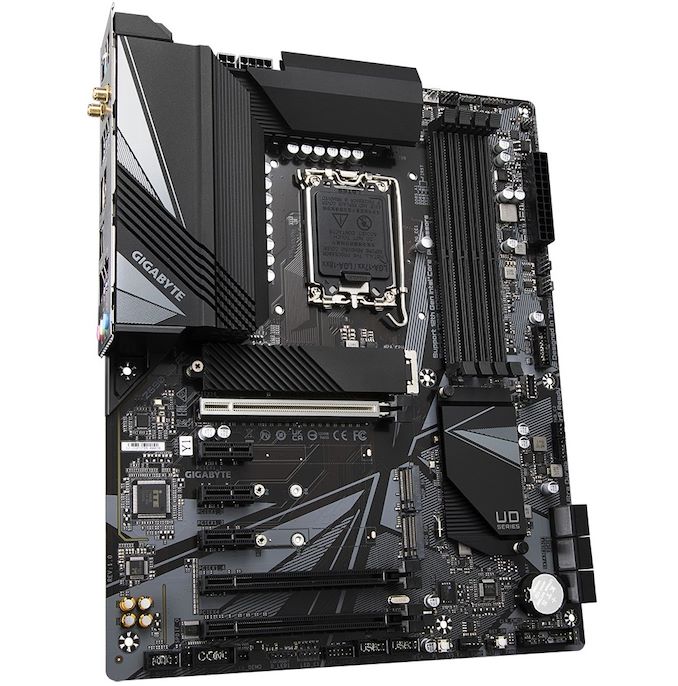The Intel Z690 Motherboard Overview (DDR4): Over 30+ New Models
by Gavin Bonshor on November 24, 2021 2:00 PM ESTGIGABYTE Z690 UD AX, UD AC & UD (DDR4)
Moving onto GIGABYTE's entry-level Z690 models with support for DDR4 memory, we have three near-identical representatives from its Ultra Durable series (UD). All three GIGABYTE Z690 UD DDR4 based models feature the same black and grey aesthetic, as well as the same core feature set. The only difference between the three comes in the level of wireless CNVi it includes.
- GIGABYTE Z690 UD AX DDR4 = Intel AX201 Wi-Fi 6 CNVi
- GIGABYTE Z690 UD AC DDR4 = Intel Wi-Fi AC 9560 CNVi
- GIGABYTE Z690 UD DDR4 = No CNVi
Other than the wireless networking configuration, all three GIGABYTE Z690 UD models are exactly the same.
Looking at the expansion slot support of all three models, GIGABYTE includes one full-length PCIe 5.0 x16 slot, one full-length PCIe 3.0 x4 slot, one full-length PCIe 3.0 x1 slot, with three smaller PCIe 3.0 x1 slots. Storage options consist of three M.2 slots, with all three conforming to PCIe 4.0 x4 M.2, while a total of six SATA ports include support for RAID 0, 1, 5, and 10 arrays. The DDR4 versions of the Z690 UD AX, Z690 UD AC, and Z690 UD all come with four memory slots, with support for DDR4-5333, with a combined capacity of up to 128 GB.
As mentioned at the top of the page, the only difference between the three UD models is the level of Wi-Fi CNVi included, although the regular Z690 UD omits any form. Across all three models are one USB 3.2 G2x2 Type-C, one USB 3.2 G2 Type-A, four USB 3.2 G1 Type-A, and four USB 2.0 ports. There are three 3.5 mm audio jacks powered by an unspecified Realtek HD audio codec, while GIGABYTE does include a DisplayPort and HDMI video output for users planning on using Intel's integrated graphics. All three models include one Realtek RTL8125 2.5 GbE controller, while a PS/2 combo port for legacy peripherals finishes off the modest rear panels.












42 Comments
View All Comments
meacupla - Wednesday, November 24, 2021 - link
Those boards are probably still stuck in the Pacific.Mat-mat - Thursday, November 25, 2021 - link
Why not include the Z690 TORPEDO, Z690 ACE, Z690 FORCE, Z690 Taichi, Z690 AORUS XTREME and Z690M DS3H DDR4 (not yet released).By the way, love the fact that the Phantom Gaming 4 boards look no-nonsense in style, while it has DrMOS MOSFETs for VRM power delivery.
PlasticMouse - Thursday, November 25, 2021 - link
Small typo: Previously with 11th gen (Rocket Lake), Intel upheaved it from a PCIe 3.0 x4 uplink on Z490 to a PCIe 3.0 x4 (x8?) uplink on Z590. With Z690, the uplink is now fully-fledged PCIe 4.0 x8 lanes to interconnect things.GarBaGe - Thursday, November 25, 2021 - link
"Intel upheaved it from a PCIe 3.0 x4 uplink on Z490 to a PCIe 3.0 x4 uplink on Z590. With Z690, the uplink is now fully-fledged PCIe 4.0 x8 lanes to interconnect things."This is wrong. Probably just a typo, since the author uses a phrasing which suggests it is a typo.
Z490 has 4 links PCIe 3 from CPU to chipset.
Z590 has 8 links (not 4) PCIe 3 from CPU to chipset
Z690 has 8 links PCIe 4 from CPU to chipset.
My question to Intel: If Z690 is supposed to be your first PCIe 5 platform, why not use PCIe 5 from CPU to chipset instead of PCIe 4?
DazFG - Thursday, November 25, 2021 - link
what listing motherboards with diagnostic panels for overclockers, or how many power phases.cgull.at - Thursday, November 25, 2021 - link
This has been irritating me a bit for a while: "Over 30+ new models"That's redundant. It's like saying "More than more than 30 new models". Pick one or the other. Please?
T2daroy - Thursday, November 25, 2021 - link
I'm considering the MSI MPG Z690 Edge WIFI DDR4. What are your thoughts on this?quantumshadow44 - Thursday, November 25, 2021 - link
}}}While Intel states that it includes an integrated 2.5 GbE MAC/PHY, this is a little nonsensical, as wired ethernet still requires a MAC/PHY as an attached PCIe controller. This means regardless of whether a vendor is using a Gigabit, 2.5 GbE, or even 10 GbE, it connects the exact same way to the PCIe interface.Can someone explain to me why is it "nonsensical"? Thanks.
GreenReaper - Saturday, November 27, 2021 - link
I think the assertion is that the chipset doesn't contain anything to enable this. It's like "you could buy [a motherboard with] a PCIe-based 2.5Gbps Ethernet solution, and it could be from Intel, so we'll list it as a feature".Conversely, for 1Gbps, the Z690 spec sheet lists: "Intel® Integrated 10/100/1000 MAC: Support for the Intel® Ethernet Connection I219-V" - https://ark.intel.com/content/www/us/en/ark/produc...
If you read the datasheet for that it suggests that the I219-V basically turns one of the PCIe links to the PCH ("chipset") into a half-speed Gen1 2.5Gbps connection - but it's not actually the PCIe protocol, it sends Ethernet packets from the I219-V PHY to be handled by the PCH. It also works in SMBus mode at 10Mbps to provide functionality when the machine is a lower-power state.
There is a lot of wake-up functionality which means it has to be able to detect bit patterns, direct-addressed IPv4/6 wakeups, etc, but it relies on chipset features to otherwise process packets.
ScottSoapbox - Saturday, November 27, 2021 - link
"Intel upheaved it from a PCIe 3.0 x4 uplink on Z490 to a PCIe 3.0 x4 uplink on Z590."